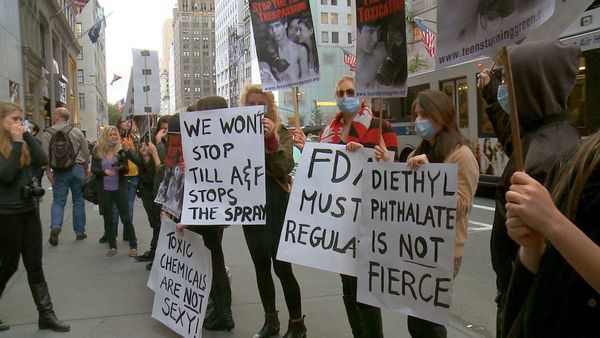Eye For Film >> Movies >> The Human Experiment (2013) Film Review
The Human Experiment
Reviewed by: Jennie Kermode

When it comes to chemicals in the domestic environment, there tend to be two schools of thought. One holds that there are poisons all around us, that we have been lied to about what is safe by companies only interested in profit, and that corrupt governments are happy to overlook this. The other holds that this is nonsense, that there are good political and economic reasons why such risks would not occur, and that objections are rooted in pseudoscience and panic. This documentary leans toward the former but grounds itself with some solid science and has a few shocks in store for the latter.
It's easy, in the UK, to feel relatively comfortable with product regulation standards. In the US, however, such regulation is notoriously more lax. Although this film stretches the truth a bit in suggesting it's entirely absent, it has plenty of genuine facts with which to disturb viewers, including Americans who didn't realise how little protection they had. Much of US law only applies to new compounds, with chemicals previously in use assumed to be safe until proven otherwise. The film compares this to the situation when tobacco companies argued that their products should not be regulated. It took decades to resolve that battle, and there are thousands of chemicals which could potentially be harmful.
Before going further, it's worth noting that the film never provides a definition of what it means by 'chemical'. If we overlook the fact that all matter is comprised of chemicals, we might assume it is talking about artificially manufactured chemical compounds (i.e. substances not found in nature). This becomes problematic, however when it turns its attention to simple elements like arsenic and lead. The result is an underlying sense of confusion which undermines the film's scientific credentials - a shame, because there are some genuinely impressive studies cited here, often accompanied by interviews with the researchers involved.
The film runs into similar difficulty when it comes to the conditions allegedly triggered by the presence of some of these substances. It's one thing to point to a rise in cases of breast cancer among pre-menopausal women, as this is a disease which has been consistently tracked, using the same diagnostic criteria, since the 18th Century. It's quite another thing to do that with autism, where diagnostic tools have improved considerably over the past two decades and 'high functioning' people are now routinely diagnosed where previously they might simply have been dismissed as unusual. A bit of judicious editing, cutting out the more dubious arguments in the film, would have made the remaining part look stronger.
Another difficulty the film faces - for more understandable reasons - is balancing engaging human interest stories with the reality that some patterns of cause and effect can only be identified from looking at large scale data. It's reasonable to map the use of bisphenol A in baby bottles against cases of cancer and infertility to identify a problem (one sufficiently clear to have led to its use in baby products being banned in Europe), but we can't possibly know if this is the cause of the problems suffered by the young couple the film follows, who are desperately trying to conceive. Nevertheless, though this might usefully have been made clearer, their story is undeniably moving, as are those of others who perceive themselves as victims of domestic pollution. These stories work well as illustrations of suffering, but not as testaments to cause and effect.
Where the film is more effective is in its exploration of the politics behind chemical regulation in America, which also communicates quite a bit about wider problems within the system. The existence of fake pressure groups and the passing of bribes may be taken for granted by cynics but it's still quite something to see them in action. The film effectively captures the schmaltzy testimony of an 11 year old boy brought in to beg that a particular fire retardant not be taken off the market, presumably unaware that it may be causing long term damage to his health. There's a brief analysis of the psychology of risk, noting the inbuilt human bias toward short term concerns.
As narrator, Sean Penn is used sparingly, but his measured approach, never showy, lends the film much-needed weight. It's still uneven and it feels very much like a first stab at a subject by people who still have a good bit more to learn, but if its aim is to wake Americans up to the potential hazards around them, it certainly does its job. Les clear is how much better the proposed alternatives are - the term 'green products' is bandied about with, again, no definition provided - but that might be an interesting subject for the filmmakers to return to in future.
Reviewed on: 11 Apr 2015














